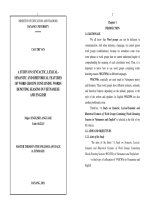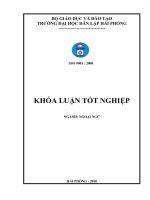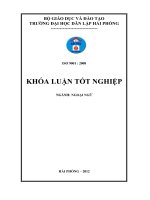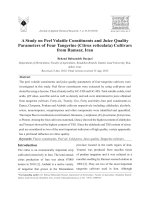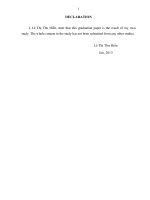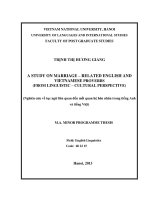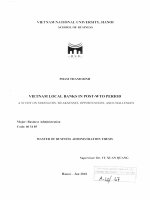a study on peel volatile constituents and juice quality
Bạn đang xem bản rút gọn của tài liệu. Xem và tải ngay bản đầy đủ của tài liệu tại đây (582.35 KB, 14 trang )
Journal of Applied Chemical Research, 7, 4, 25-38 (2013)
Journal of
Applied
Chemical
Research
www.jacr.kiau.ac.ir
A Study on Peel Volatile Constituents and Juice Quality
Parameters of Four Tangerine (Citrus reticulata) Cultivars
from Ramsar, Iran
Behzad Babazadeh Darjazi
Department of Horticulture, Faculty of Agriculture, Roudehen Branch, Islamic Azad University, Rou-
dehen, Iran.
Received 11 Jun. 2013; Final version received 15 Aug. 2013
Abstract
The peel volatile constituents and juice quality parameters of four tangerine cultivars were
investigated in this study. Peel avor constituents were extracted by using cold-press and
eluted by using n-hexane. Then all analyzed by GC-FID and GC-MS. Total soluble solids, total
acids, pH value, ascorbic acid as well as density and ash were determined in juice obtained
from tangerine cultivars. Forty-six, Twenty- ve, Forty and thirty-four peel constituents in
Dancy, Cleopatra, Ponkan and Atabaki cultivars respectively including: aldehydes, alcohols,
esters, monoterpenes, sesquiterpenes and other components were identied and quantied.
The major avor constituents were linalool, limonene, γ-terpinene, (E)-β-ocimene, β-myrcene,
α-Pinene. Among the four cultivars examined, Dancy showed the highest content of aldehydes
and Younesi showed the highest content of TSS. Since the aldehyde and TSS content of citrus
peel are considered as two of the most important indicators of high quality, variety apparently
has a profound inuence on citrus quality.
Keywords: Flavor constituents, Peel oil, Cold-press, Juice quality, Tangerine cultivars.
Introduction
The citrus is an economically important crop
cultivated extensively in Iran. The total annual
citrus production of Iran was about 87000
tonnes in 2010 [1]. Atabaki is a native variety
of tangerine that grown in the Mazandaran
province located in the north region of Iran.
Younesi was produced from nucellar tissue
of ponkan tangarine and it was cultured as a
nucellar seedling by Ramsar research station in
1968 [2]. They are two of the most important
tangerine cultivars used in Iran. Although
*Corresponding author: Dr. Behzad Babazadeh Darjazi, Department of Horticulture, Faculty of Agriculture, Roudehen Branch,
Islamic Azad University, Roudehen, Iran., E-mail: babazadeh @riau.ac.ir. Tel: +98 21 33009743.
B. B. Darjazi et al., J. Appl. Chem. Res., 7, 4, 25-38 (2013)
26
they are as important cultivars, the avor
components of Atabaki and Younesi have not
been investigated before.
Dancy tangerine was rediscovered by G. L.
Dancy in Morocco and brought to Florida
in 1867. It has been regarded as a Citrus fruit
with potential commercial value because of its
attractive and pleasant aroma [2]. In Citrus L.
species essential oils occur in special oil glands
in owers, leaves, peel and juice. These valuable
essential oils are composed of many compounds
including: terpenes, sesquiterpenes, aldehydes,
alcohols, esters and sterols. They may also
be described as mixtures of hydrocarbons,
oxygenated compounds and nonvolatile
residues. Essential oils of citrus are used
commercially for avoring foods, beverages,
perfumes, cosmetics, medicines, etc [3].
The insecticidal, antimicrobial, antioxidative
and antitumor properties of Citrus peel oils
have recently been reported [4]. Oxygenated
compounds, mainly oxygenated terpenes,
have been found to be responsible for the
characteristic odor and avor of Citrus fruits
[4]. The quality of an essential oil may be
calculated from the quantity of oxygenated
compounds present in the oil. The quantity of
oxygenated compounds present in the oil, is
variable and depends upon a number of factors
including: rootstock [5, 6], cultivars or scions
[7-9], seasonal variation [10], organ [11],
method [12] and etc.
Branched aldehydes and alcohols are important
avor compounds in many food products [3].
Various studies have shown that the tangerine-like
smell is mainly based on carbonyl compounds,
such as α-sinensal, geranial, citronellal,
decanal and perilaldehyde [13]. The quality of
a honey may be calculated from the amount of
oxygenated components present in the honey
[14, 15] and various owers may inuence the
quality of volatile avor components present in
the honey. It had been recognized previously that
oxygenated compounds are important factor in
deceiving and attracting the pollinators. These
results may have consequences for yield in
agricultural [16, 17].
Citrus juice is the most popular beverage
in the world because of the fantastic avor
and abundant nutrition. The juice quality of
citrus is an important economic factor in an
industry that buys its fruit based on the juice
sugar content and processes over 95% of its
crop [18]. The greatest amounts of the high
quality juices are consumed by the food and
beverage industries. The quality of a juice
may be calculated not only with the amount
of oxygenated components present in the juice
but also with concentration of compositions
such as TSS, acids and vitamin C [5]. In citrus,
fruit juice content, TSS and TA concentration
are the main internal quality parameters used
all over the world [19]. TSS content also forms
the basis of payment for fruit by some juice
processors in a number of countries, especially
where the trade in juice is based on frozen
B. B. Darjazi et al., J. Appl. Chem. Res., 7, 4, 25-38 (2013)
27
Table 1. Common and botanical names for citrus taxa used as scions and rootstock [2].
Common name
botanical name Parents category
Dancy(scion)
Citrus reticulata cv. Dancy Unknown
Tangerine
Cleopatra (scion)
Citrus reticulata
(C.reshni
Hort.ex.Tan) cv. Cleopatra Unknown Tangerine
Younesi (scion)
Citrus reticulata cv. Younesi Unknown Tangerine
Atabaki(scion)
Citrus reticulata
cv.
Atabaki
Unknown
Tangerine
Sour orange
(Rootstock)
Citrus aurantium Mandarin ×Pomelo Sour orange
concentrate [20]. The quantity of TSS, present
in the juice, is variable and depends upon a
number of factors including: rootstock, scion
or variety, degree of maturity, seasonal effects,
climate, nutrition, tree age and etc [20].
Various studies have shown that the scion or
variety used may inuence the quantity of
chemical compositions (TSS, TA and vitamin
C) present in the juice [21]. Compared with
orange juice, very little research has been
carried out on tangerine juice. Therefore,
it is very important to be able to assess the
differences between tangerine cultivars in
terms of quantity of compositions (TSS, acids
and vitamin C).
In this paper, we compare the peel volatile
compounds isolated from four different
tangerines with the aim of determining whether
the quantity of oxygenated compounds was
inuenced by the variety. Also the present
study reports the effects of variety on the juice
quality parameters with the aim of verifying if
they were inuenced by the variety.
Experimental
Tangerine scions
In 1989, tangerine scions that grafted on
Sour orange rootstock, were planted at 8×4
m with three replication at Ramsar research
Site [Latitude 36° 54’ N, longitude 50° 40’ E;
Caspian Sea climate, average rainfall 970 mm
per year and average temperature16.25°C; soil
was classied as loam-clay, pH range (6.9 to
7)]. Dancy, Cleopatra, Ponkan and Atabaki
were used as cultivars in this experiment
(Table 1).
Preparation of peel sample
In the last week of January 2012, at least 10
mature fruit were collected from many parts of
the same trees located in Ramsar research Site.
About 150 g of fresh peel was cold-pressed
and then the oil was separated from the crude
extract by centrifugation (at 4000 RPM for 15
min at 4 °C). The supernatant was dehydrated
with anhydrous sodium sulfate at 5 °C for 24h
and then ltered. The oil was stored at -25 °C
until analyzed [22].
Preparation of juice sample
In the last week of January 2012, at least 10
B. B. Darjazi et al., J. Appl. Chem. Res., 7, 4, 25-38 (2013)
28
mature fruit were collected from many parts of
the same trees located in Ramsar research Site.
Juice was obtained by using the Indelicate
Super Automatic, Type A2 104 extractor. After
extraction, juice is screened to remove peel,
membrane, pulp and seed pieces according
to the standard operating procedure. Each
juice replicate was made with 10 tangerines.
Three replicates were used for the quantitative
analysis (n=3) [23].
Chemical methods
The total titratable acidity was assessed by
titration with sodium hydroxide (0.1 N) and
expressed as % citric acid. Total soluble solids,
expressed as Brix, were determined using a Carl
Zeiss, Jena (Germany) refractometer. The pH
value was measured using a digital pH meter
(WTW Inolab pH-L1, Germany). Ascorbic acid
was determined by titration with Potassium
iodide. The density of the juice was measured
using a pycnometer and ash was determined by
igniting a weighed sample in a mufe furnace
at 550 c to a constant weight [24].
GC and GC-MS
An Agilent 6890N gas chromatograph (USA)
equipped with a DB-5 (30 m 0.25 mm i.d;
lm thickness = 0.25 μm) fused silica capillary
column (J&W Scientic) and a ame ionization
detector (FID) was used. The column temperature
was programmed from 60 o C (3min) to 250 o C
(20 min) at a rate of 3 o C/ min. The injector and
detector temperatures were 260
o
C and helium
was used as the carrier gas at a ow rate of 1.00
ml/min and a linear velocity of 22 cm/s. The
linear retention indices (LRIs) were calculated
for all volatile components using a homologous
series of n-alkanes (C9-C22) under the same GC
conditions. The weight percent of each peak was
calculated according to the response factor to the
FID. Gas chromatography- mass spectrometry
was used to identify the volatile components.
The analysis was carried out with a Varian
Saturn 2000R. 3800 GC linked with a Varian
Saturn 2000R MS. The oven condition, injector
and detector temperatures, and column (DB-
5) were the same as those given above for the
Agilent 6890 N GC. Helium was the carrier gas
at a ow rate of 1.1 mL/min and a linear velocity
of 38.7 cm/s. Injection volume was 1 μL.
Identication of Components
Components were identied by comparing
their LRIs and matching their mass spectra
with those of reference compounds in the data
system of the Wiley library and NIST Mass
Spectral Search program (Chem. SW. Inc;
NIST 98 version database) connected to a
Varian Saturn 2000R MS. Identications were
also determined by comparing the retention
time of each compound with that of known
compounds [25, 26].
Data analysis
SPSS 18 was used for analysis of the data
B. B. Darjazi et al., J. Appl. Chem. Res., 7, 4, 25-38 (2013)
29
obtained from the experiments. Analysis of
variations was based on the measurements of
11 peel component and 6 juice characteristics.
Variations among and within cultivars were
analyzed using analysis of variance (ANOVA)-
one way. Correlation between pairs of characters
and altitude was evaluated using Pearson’s
correlation coefcient (Table 2 and 3).
Table 2. Statistical analysis of variation in peel flavor Components
of
tangerine cultivars (see Materials and
methods). Mean is average composition in % over the different cultivars used with three replicates. St.
err=standard error. F value is accompanied by its significance, indicated by: NS = not significant, * = significant
at P = 0.05, ** = significant at P = 0.01.
Compounds
Dancy Cleopatra Younesi Atabaki
Mean St.err Mean St.err Mean St.err Mean St.err
F
value
Oxygenated compounds
a) Aldehyds
1) Octanal
0.29 0.01 0.34 0.04 0.25 0.02 0.24 0.01 F**
2) Nonanal
0.08 0 0.01 0.006 0.05 0.006 0.05 0.01
3) Citronellal
0.04 0 0 0 0.05 0.006 0.03 0.006
4) Decanal
0.2 0.006 0.18 0 0.2 0.01 0.11 0.01 F**
5) Neral
0.01 0 0 0 0.04 0 0 0
6) (E)-2-decenal
0.01 0.006 0 0 0.007 0.003 0 0
7) Geranial
0.02 0.006 0.01 0 0.007 0.003 0.008 0.002
8) Perilla aldehyde
0.01 0.006 0.02 0.006 0.01 0 0.01 0.006
9) Undecanal
0.01 0.001 0 0 0.008 0.003 0 0
10) (E)2,4-decadienal
0.004 0.001 0 0 0.009 0.001 0 0
11) Dodecanal
0.01 0 0.03 0 0.02 0.01 0.01 0
12) Tetradecanal
0.02 0 0 0 0 0 0 0
13) ȕ-sinensal
0 0 0 0 0.009 0.001 0.009 0.002
14) Į-sinensal
0.14 0.02 0 0 0.01 0.01 0.02 0.01
total
0.84 0.05 0.59 0.05 0.67 0.07 0.48 0.05
b) Alcohols
1) linalool
1.130 0.100 0.770 0.006 0.860 0.090 0.560 0.060 F**
2) Terpinen-4-ol
0.009 0.001 0 0 0.010 0.000 0.010 0.000
3) Į-terpineol
0.080 0.000 0.080 0.000 0.070 0.006 0.070 0.000
4) ȕ-citronellol
0.030 0.000 0 0 0.010 0.006 0.007 0.003
5) Nerol
0 0 0.007 0.003 0 0 0 0
6) Thymol
0.090 0.000 0 0 0 0 0.020 0.000
7) Elemol
0.010 0.006 0 0 0 0 0 0
8) Germacrene D-4-ol
0.003 0.001 0 0 0 0 0 0
total
1.35 0.10 0.85 0.01 0.95 0.10 0.66 0.06
c) Esters
1) Citronellyl acetate
0.007 0.001 0 0 0.007 0.003 0 0
2) Neryl acetate
0.01 0 0.01 0 0.009 0.002 0 0
3) Granyl acetate
0.009 0 0 0 0.007 0.003 0 0
total
0.02 0.001 0.01 0 0.02 0.008 0 0
Monoterpenes
1) Į-thujene
0.16 0.006 0 0 0.26 0.006 0.16 0.006
2) Į-pinene
0.88 0.06 0.59 0.03 1.16 0.07 0.9 0.03 F**
3) Sabinene
0.12 0.02 1.91 0.08 0.41 0.03 0.39 0.09 F**
4) ȕ- pinene
0.33 0.01 0.04 0.01 0.63 0.04 0.39 0.03 F**
5) ȕ-myrcene
1.68 0.08 1.76 0.11 1.82 0.1 1.67 0.05 NS
6) Į-terpinene
0.02 0.01 0 0 0.03 0.01 0.06 0.02
7) Limonene
87.07 0.7 92.01 0.55 84.24 2.19 87.22 1.06
F**
8) (E)-ȕ-ocimene
1.13 0.42 1.33 0.55 1.14 0.31 1.03 0.25 NS
9) Ȗ-terpinene
4.68 0.51 0.18 0.03 7.43 1.02 5.29 0.01 F**
10) (E)-sabinene hydrate
0.09 0.01 0.05 0.01 0.11 0.02 0.09 0.02
B. B. Darjazi et al., J. Appl. Chem. Res., 7, 4, 25-38 (2013)
30
11) Į-terpinolene
0.23 0.05 0 0 0.39 0.11 0.26 0.05
12) Trans-limonene oxide
0 0 0 0 0.005 0 0 0
total
96.39 1.87 97.87 1.37 97.62 3.9 97.46 1.61
Sesquiterpenes
1) į-elemene
0.01 0 0.15 0 0.03 0.006 0.04 0.006
2) Į-copaene
0.008 0.002 0 0 0 0 0 0
3) ȕ-elemene
0.05 0.006 0.05 0.006 0.01 0.006 0.01 0.006
4) (Z)-ȕ-caryophyllene
0.01 0 0 0 0 0 0 0
5) Ȗ-elemene
0.05 0.01 0.06 0.01 0.01 0 0.01 0.006
6) Į-humulene
0 0 0 0 0.01 0.006 0.01 0
7) (Z)-ȕ-farnesene
0.01 0 0.01 0.006 0 0 0 0
8) Germacrene D
0.1 0.006 0.11 0.006 0.03 0 0.04 0
F**
9) Bicyclogermacrene
0.02 0 0 0 0 0 0 0
10) E,E-Į-farnesene
0.01 0 0 0 0.006 0 0.007 0.002
11) į-cadinene
0.02 0.01 0.01 0 0.009 0.001 0.01 0
12) Germacrene B
0.05 0.006 0.05 0.006 0.01 0 0.01 0
total
0.33 0.04 0.44 0.03 0.11 0.01 0.13 0.02
Other compounds
1)Thymol methyl ether
0.04 0.006 0 0 0 0 0.03 0.006
Total oxygenated
compounds
2.21 0.15 1.45 0.06 1.64 0.17 1.14 0.11
Total
98.97 2.06 99.76 1.46 99.37 4.08 98.76 1.74
Table 3.
Statistical analysis of variation in juice quality parameters of tangerine cultivars. Mean is average
parameter in % over the different cultivars used with three replicates. St. err = standard error. F value is
accompanied by its significance, indicated by: NS = not significant, * = significant at P = 0.05, ** = significant
at P = 0.01.
Cultivars
TSS (%)
Total Acids
(%)
TSS /TA
rate
Ascorbic acid
(%)
PH Juice (%)
Total dry
matter (%)
Ash (%)
Dancy
(scion)
9 0.87 10.34 43.82 3.42 71.61 14.79 1
Cleopatra
(scion)
7.6 2.81 2.70 27.81 2.93 64 17.56 3
Younesi
(scion)
10.4 0.71 14.64 29.04 3.53 71.18 14.80 3
Atabaki
(scion)
8 1.11 7.20 36.61 3.31 55.55 13.21 3
F** F** F** F** F** F**
Results and discussion
Flavor compounds of the ‘Dancy’ tangerine peel
GC-MS analyze of the avor compounds
extracted from ‘Dancy’ tangerine peel by using
cold-press allowed identication of 46 volatile
components (Table 4, Figure1): 23 oxygenated
terpenes [13 aldehydes, 7 alcohols, 3 esters],
22 non oxygenated terpenes [11 monoterpens,
11 sesqiterpens] and 1 other compound.
B. B. Darjazi et al., J. Appl. Chem. Res., 7, 4, 25-38 (2013)
31
Flavor compounds of the ‘Cleopatra’ tangerine
peel
GC-MS analyze of the avor compounds
extracted from ‘Cleopatra’ tangerine peel by
using cold-press allowed identication of 25
volatile components (Table 4) : 10 oxygenated
terpenes [6 aldehydes , 3 alcohols, 1 esters],
15 non oxygenated terpenes [8 monoterpens,
7 sesqiterpens].
Flavor compounds of the ‘Younesi’ tangerine
peel
GC-MS analyze of the avor compounds
extracted from ‘Younesi’ tangerine peel by
using cold-press allowed identication of 40
volatile components (Table 4): 20 oxygenated
terpenes [13 aldehydes, 4 alcohols, 3 esters],
20 non oxygenated terpenes [12 monoterpens,
8 sesqiterpens].
Flavor compounds of the ‘Atabaki’ tangerine
peel
GC-MS analyze of the avor compounds
extracted from ‘Atabaki’ tangerine peel by
using cold-press allowed identication of 34
volatile components (Table 4): 14 oxygenated
terpenes [9 aldehydes, 5 alcohols], 19 non
oxygenated terpenes [11 monoterpens, 8
sesqiterpens] and 1 other compound.
Figure 1. HRGC chromatograms of ‘Dancy’ tangerine peel oil.
B. B. Darjazi et al., J. Appl. Chem. Res., 7, 4, 25-38 (2013)
32
Table 4. Peel volatile components of tangerine cultivars. (*There is in oil).
Component Dancy Cleopatra Younesi Atabaki
KI Component Dancy Cleopatra Younesi Atabaki KI
1 Į- thujene * * * 928 28 Thymol * * 1291
2 Į - Pinene * * * * 935 29 Undecanal * * 1307
3 Sabinene * * * * 975 30 (E)2,4-decadienal * * 1322
4 ȕ -pinene * * * * 979 31 į- elemene * * * * 1344
5 ȕ -myrcene * * * * 991 32 Citronellyl acetate * * 1349
6 octanal * * * * 1003 33 Neryl acetate * * * 1356
7 Į-phellandrene 1006 34 Į -copaene * 1385
8 Į -terpinene * * * 1021 35 Granyl acetate * * 1389
9 Limonene * * * * 1036 36 ȕ -cubebene 1396
10 (E)- ȕ - ocimene * * * * 1049 37 ȕ -elemene * * * * 1399
11 Ȗ - terpinene * * * * 1061 38 Dodecanal * * * * 1409
12
(E)sabinene
hydrate
* * * * 1070 39 (Z)- ȕ -caryophyllene * 1415
13 Į -terpinolene * * * 1091 40 Ȗ - elemene * * * * 1440
14 Linalool * * * * 1100 41 (Z)- ȕ - farnesene * * 1453
15 Nonanal * * * * 1109 42 Į - humulene *
*
1466
16
Trans-limonene
oxide
* 1141 43 Germacrene D *
*
* * 1493
17 Citronellal * * * 1154 44 Valencene 1499
18 Terpinene-4-ol * * * 1182 45 Bicyclogermacrene * 1504
19 Į - terpineol * * * * 1195 46 E,E, Į - farnesene * * * 1514
20 Decanal * * * * 1205 47 į-cadinene * * * * 1532
21 ȕ -citronellol * * * 1229 48 Elemol * 1559
22 Nerol * 1231 49 Germacrene B * * * * 1572
23
Thymol methyl
ether
* * 1236 50 Germacrene D-4-ol * 1588
24 Neral * * 1244 51 Tetradecanal * 1612
25 (E)-2-decenal * * 1263 52 ȕ - sinensal * * 1704
26 Geranial * * * * 1275 53 Į -sinensal * * * 1756
27 Perilla aldehyde * * * * 1282 46 25 40 34
Aldehydes
Fourteen aldehyde components that identied
in this analysis were octanal, nonanal,
citronellal, decanal, neral, (E)-2-decenal,
geranial, perillaldehyde, undecanal, (E)-2,4-
decadienal, dodecanal, tetradecanal, β-sinensal
and α-sinensal (Table 2). In addition they were
quantied [from 0.48% to 0.84%] that it was
determined and reported as relative amount of
those compounds in oil. The concentrations
of octanal and decanal were higher in our
samples. Octanal has a citrus-like aroma, and
is considered as one of the major contributors
to tangerine avor [13]. Among the four
cultivars examined, Dancy showed the highest
content of aldehydes (Table 2). Since the
aldehyde content of citrus oil is considered as
one of the most important indicators of high
quality, cultivars apparently has a profound
inuence on tangerine oil quality.
B. B. Darjazi et al., J. Appl. Chem. Res., 7, 4, 25-38 (2013)
33
Dancy aldehydes were also compared to those
of Cleopatra, Younesi and Atabaki in this
study. Tetradecanal was identied in Dancy,
while it was not detected in the Cleopatra,
Younesi and Atabaki. Compared with Atabaki,
the Dancy improved and increased aldehyde
components about1.75 times (Table 2).
Alcohols
Eight alcohol components identied in
this analysis were linalool, terpinene-4-ol,
α-terpineol, β-citronellol, Nerol, thymol,
elemol, Germacrene D-4-ol (Table 2). The
total amount of alcohols ranged [from 0.66%
to 1.35%] that it was determined and reported
as relative amount of those compounds in
oil. Linalool was the major component in
this study and it was the most abundant.
Linalool has been recognized as one of the
most important components for tangerine peel
oil avor. Linalool has a owery aroma [13]
and its level is important to avor character in
tangerine peel oil [3]. Among the four cultivars
examined, Dancy showed the highest content
of alcohols (Table 2). Dancy alcohols were also
compared to those of Cleopatra, Younesi and
Atabaki in this study. Elemol and germacrene
D-4-ol were identied in Dancy, while they
were not detected in Cleopatra, Younesi and
Atabaki. Compared with Atabaki, the Dancy
improved and increased alcohol components
about 2 times (Table 2).
Esters
Three ester components identied in the
analysis were citronellyl acetate, neryl acetate,
geranyl acetate. The total amount of esters
ranged [from 0.00% to 0.02%]. Among the
four cultivars examined, Dancy showed the
highest content of esters in oil (Table 2).
Monoterpenes hydrocarbons
The total amount of monoterpene hydrocarbons
ranged [from 96.39 % to 97.87%]. Limonene
was the major component among the
monoterpene hydrocarbons of tangerine peel
oil. Limonene has a weak citrus-like aroma
[13] and is considered as one of the major
contributors to tangerine avor [3]. Among
the four cultivars examined, Cleopatra had
the highest monoterpenes hydrocarbons in oil
(Table 2)
Sesquiterpenes hydrocarbons
The total amount of sesquiterpene
hydrocarbons ranged [from 0.11 % to 0.44
%]. Germacrene D was the major component
among the sesquiterpen hydrocarbons of
tangerine peel oil. Among the four cultivars
examined, Cleopatra had the highest
sesquiterpenes content in oil (Table 2).
Juice quality parameters
Juice quality parameters are given in Table 3.
The content of total acids was from 0.71 %
(Younesi) to 2.81 % (Cleopatra), and Brix (total
B. B. Darjazi et al., J. Appl. Chem. Res., 7, 4, 25-38 (2013)
34
soluble solids) was from 7.6 % (Cleopatra) to
10.4% (Younesi). TSS/TA rate was from 2.70
% (Cleopatra) to 14.64% (Younesi). Ascorbic
acid was from 27.81 % (Cleopatra) to 43.82%
(Dancy). The pH value was from 2.93 %
(Cleopatra) to 3.53% (Younesi). The juice
yield was from 55.55 % (Atabaki) to 71.61%
(Dancy). Ash was from 1 % (Dancy) to 3 %
(Cleopatra, Younesi and Atabaki). Total dry
matter was from 13.21% (Atabaki) to 17.56
% (Cleopatra). Among the four cultivars
examined, Younesi showed the highest content
of TSS, TSS /TA and pH. The lowest of TSS,
TSS /TA and pH were produced by Cleopatra.
Among cultivars, Dancy had the highest juice
content and Ascorbic acid. (Table 4).
Statistical analyses
Statistical analysis was performed on the peel
and juice data using SPSS 18. The Duncan’s
multiple range tests was used to separate the
signicant cultivars. Among all analyzed, 15
showed statistically signicant differences due
to the inuence of different cultivars. These
differences on the 1% level occurred in Octanal,
decanal, linalool, α-pinen, β- pinene, sabinene,
limonene, γ-terpinene, Germacrene D, TSS,
TA, TSS /TA, Ascorbic acid, pH, Juice. The
non affected oil components were β-myrcen
and (E)-β-ocimene that they are provided only
for convenience of the reader (Table 3 and 5).
Results of correlation
Simple intercorrellations between 11 peel
components are presented in a correlation
matrix (Table 5). The highest positive values
or r (correlation coefcient) were between
[γ-terpinene and β-pinene (98%)]; [β-pinene
and α-pinene (97%)]; [γ-terpinene and
α-pinene (97%)]. The highest signicant
negative correlations were between [limonene
and α-pinene (96%)] ; [γ-terpinene and
limonene (96%)]; [limonene and β-pinene
(93%)] (Table 3).
Table 5. Correlation matrix (numbers in this table correspond with main components mentioned in Table 2.
*=significant at 0.05
**=significant at 0.01
Ȗ-terpinene
(E)-ȕ-
ocimene
limoneneǺ-myrceneȕ- pinene sabinene Į-pinene linalool decanalOctanal
0.39
decanal
0.83**0.33
linalool
0.170.15-0.65*
Į-pinene
-0.74**-0.260.020.68*
sabinene
-0.76**0.97**0.070.07-0.75**
ȕ- pinene
0.200.210.330.220.390.38
Ǻ-myrcene
-0.26-0.93**0.78**-0.96**-0.25-0.150.64*
limonene
0.040.05-0.130.30-0.150.180.130.08
(E)-ȕ-ocimene
-0.14-0.96**0.160.98**-0.84**0.97**0.120.02-0.75**
Ȗ-terpinene
-0.80**0.220.71**-0.18-0.83**0.51-0.80**0.440.380.78**
Germacrene D
B. B. Darjazi et al., J. Appl. Chem. Res., 7, 4, 25-38 (2013)
35
Also simple intercorrellations between 6 juice
characteristics are presented in a correlation
matrix (Table 6). The highest positive values
or r (correlation coefcient) were between
[TSS /TA and TSS (96%)]; [pH and TSS /TA
(94%)]; [pH and TSS (0.84%)]. The highest
signicant negative correlations were between
[pH and TA (97%)]; [TSS /TA and TA (88%)]
(Table 6).
Table 6.
Correlation matrix (numbers in this table correspond with juice quality parameters mentioned in Table
3.
*=significant at 0.05
**=significant at 0.01
pH
Ascorbic
acid(%)
TSS /TA TA (%) TSS (%)
-0.73**
TA (%)
-0.88**0.96**
TSS /TA
0.17-0.51-0.02
Ascorbic acid(%)
0.400.94**-0.97**0.84**
pH
0.420.090.59*-0.280.71**
Juice (%)
Our observations that different scions or
cultivars have an effect on some of the
components of tangerine oil are accord with
other observations [7-9]. The compositions
of the peel oils obtained by cold pressing
from different cultivars of tangerine were
very similar. However, relative concentration
of compounds differed according to type of
variety. A comparison of our data with those
in the literatures revealed that some of the
peel components identied in our study are
not compatible with the published one for
Dancy and Cleopatra [7]. Also comparisons of
our data with those in the literatures revealed
that content of the juice compositions in our
study are not agree with previously published
for Younesi [21]. It may be related to rootstock
and environmental factors that can inuence
compositions. However, it should be kept
in mind that the chemical methods also have
an effect on content of the juice and peel
compositions[23]. Fertilizer [27] and irrigation
[28] affects the content of compositions
present in citrus juice. Fertilization, irrigation,
and other operations were carried out uniform
in this study so we do not believe that this
variability is results from these factors.
The discovery of geranyl pyrophosphate
(GPP), as an intermediate between mevalonic
acid and oxygenated compounds (Alcohols
and aldehyds), led to a rapid description of the
oxygenated compounds biosynthetic pathway.
The major pathway of oxygenated compounds
biosynthesis in higher plants is as below:
Mevalonic acid →
Isopentenyl Pyrophosphate →
3.3-dimethylallylpyrophosphate → geranyl
pyrophosphate → Alcohols and Aldehyds
The steps in the pathway are catalyzed by
isopentenyl pyrophosphate isomerase and
B. B. Darjazi et al., J. Appl. Chem. Res., 7, 4, 25-38 (2013)
36
geranyl pyrophosphate synthase, respectively
[29]. The pronounced enhancement in the
amount of oxygenated compounds, when
Dancy was used as the variety, showed that
either the synthesis of oxygenated compounds
is enhanced or activities of both enzymes
increased.
High positive correlations between two terpens
such as [γ-terpinene and β-pinene (98%)];
[β-pinene and α-pinene (97%)]; [γ-terpinene
and α-pinene (97%)] suggest a genetic control
[30].Whether such dependence between two
terpenes is due to their derivation of one from
another is not known. Similarly, high negative
correlations observed between [limonene and
α-pinene (96%)] ; [γ-terpinene and limonene
(96%)]; [limonene and β-pinene (93%)]
suggest that one of the two compounds is
being synthesized at the expense of the other
or of its precursor. Non-signicant negative
and positive correlations can imply
genetic and/or biosynthetic independence.
However, without a thorough knowledge
of the biosynthetic pathway, leading to each
terpenoid compound, the true signicance
of these observed correlations is not clear.
The highest positive value (correlation) was
between [γ-terpinene and β-pinene (98%)].
This result indicated which these compounds
were under the control of a single dominant
gene [30] (Table 3).
Due to the fact that acetate is necessary for
the synthesis of terpenes, leads us to believe
that there is a specialized function for this
interesting molecule and that this molecule
may be better served and utilized when Dancy
is used as the variety. Our results show that
there is a positive correlation between TSS
(sugars) and pH. These doses agree with
previously published [31].
Conclusion
In the present study we found that there is
a great variation in most of the measured
characters among Dancy and other cultivars.
Dancy was distinguished from other cultivars
by its higher oxygenated compounds. These
volatile differences among different cultivars
provide fundamental information for improved
genetic understanding and future improvement
in tangerine aroma and avor. Differentiation
of different cultivars based on their aroma
proles may lead to better understanding of
genetic control of aroma production.
Many studies, such as this study is very crucial
in order to determine the amount of chemical
compositions existing in the cultivars that
we want to use, before the compositions can
be utilized in industries. Further research on
the relationship between cultivars and quality
parameters is necessary.
Acknowledgements
The author would like to express his gratitude
to Z.Kadkhoda from Institute of Medicinal
Plants located at Supa blvd-Km 55 of Tehran
B. B. Darjazi et al., J. Appl. Chem. Res., 7, 4, 25-38 (2013)
37
– Qazvin (Iran) for her help in GC-MS and
GC analysis.
References
[1] FAO, Statistical Database. Available online
in: http: //www.fao.org, Accessed 23 February
2012.
[2] R. Fotouhi- Ghazvini, J. Fattahi-
moghadam, Citrus growing in Iran, Guilan
University, Guilan (2007).
[3] A. Salem, Extraction and identication of
essential oil components of the peel, leaf and
ower of tangerine”Citrus nobilis loureior var
deliciosa swingle” cultivated at the north of
Iran, Master of Science Thesis, Islamic Azad
University, Pharmaceutical sciences Branch
(2003).
[4] F. Shahidi, Bailey’s Industrial Oil and Fat
Products, Wiley, USA (2005).
[5] B. Babazadeh- Darjazi, A. Rustaiyan, A.
Talaei, A. Khalighi, K. Larijani, B. Golein, R.
Taghizad, Iran. J. Chem. Chem. Eng., 28 (2),
99 (2009).
[6] B. Babazadeh- Darjazi, Afr. J. Agric. Res.,
6 (7), 1884 (2011).
[7] M.L. Lota, D. Serra, F. Tomi, J. Casanova,
Biochem. Syst. Ecol., 29, 77 (2001).
[8] M.L. Lota, D. Serra, F. Tomi, J. Casanova,
Biochem. Syst. Ecol., 28, 61 (2000).
[9] A.L. Fanciullino, F.Tomi, F. Luro, J.M.
Desjobert, Flavour. Fragr. J., 21, 359 (2006).
[10] B. Babazadeh- Darjazi, A. Rustaiyan, R.
Taghizad, B. Golein, J. Med. Plant., 4 (2), 87
(2011).
[11] B. Babazadeh- Darjazi, Afr. J. Biotechnol.,
10 (51), 10437 (2011).
[12] B. Babazadeh –Darjazi, J. Med. Plant.
Res., 5(13), 2840 (2011).
[13] A. Buettner, M. Mestres, A. Fischer,
J. Guasch, P. Schieberie, Eur. Food. Res.
Technol., 216, 11 (2003).
[14] E. Alissandrakis, D. Daferera, P.A.
Tarantilis, M. Polissiou, P.C. Harizanis, Food.
Chem., 82, 575 (2003).
[15] L.W. Alistair, L.U. Yinrong, T. Seng-To,
J. Agric. Food. Chem., 41 (6), 873 (1993).
[16] G. Kite, T. Reynolds, T. Prance, Biochem.
Syst. Ecol., 19(7), 535 (1991).
[17] E.S. Andrews, N. Theis, L.S. Alder, J.
Chem. Ecol., 33,1682 (2007).
[18] R.E. Rouse, Proc. Fla. State. Hort. Soc.,
113, 112 (2000).
[19] F. Antonucci, F. Pallottino, G. Paglia,
A. Palma, S.D. Aquino, P. Menesatti, Food.
Bioprocess. Technol., 4(5), 809 (2011).
[20] S. Hardy, G. Sanderson, Primefact., 980,
1 (2010).
[21] C. Nematollahi, Evaluation the effect of
Citrumelo Swingle rootstock on quantitative
and qualitative characteristics in mandarins
and orange cultivars, Final Report of Project,
Iran Citrus Research Institute, Ramsar (2005).
[22] N. T. Minh Tu, L. X. Thanh, A. Une, H.
Ukeda, M. Sawamura . Flavour. Fragr. J., 17,
169 (2002).
[23] R.J. Braddock. Hand book of Citrus by-
B. B. Darjazi et al., J. Appl. Chem. Res., 7, 4, 25-38 (2013)
38
products and processing technology, Wiley,
USA (1940).
[24] M. Majedi, Food chemical analysis
methods, University Jihad, Tehran (1994).
[25] R.P. Adams, Identication of essential oil
components by gas chromatography / mass
spectrometry, Allured Publishing Corporation,
Carol Stream, Illinois, USA (2001).
[26] F.W. McLafferty, D.B. Stauffer, The
important peak index of the registry of mass
spectral data, Wiley, USA (1991).
[27] W. Rui, S. Xue-gen, W. You-zhang1, Y.
Xiao-e1, U. Juhani, J. Zhejiang. Univ. Science
B., 7(9), 696 (2006).
[28] W.M.M. Al-Rousan, R.Y. Ajo, M.M.
Angor, T. Osaili, N.M. Bani-Hani, J. Food.
Agric. Enviro., 10 (2), 115 (2012).
[29] R.K.M. Hay, P. Waterman, Volatile
oil crops; their biology, biochemistry, and
production, Wiley-Blackwell, USA (1995).
[30] R.W. Scora, A. Esen, J. Kumamoto,
Euphytica., 25, 201 (1976).
[31] M. Knee, Fruit quality and its biological
basis, CRC Press LLC Publication, USA
(2002).

